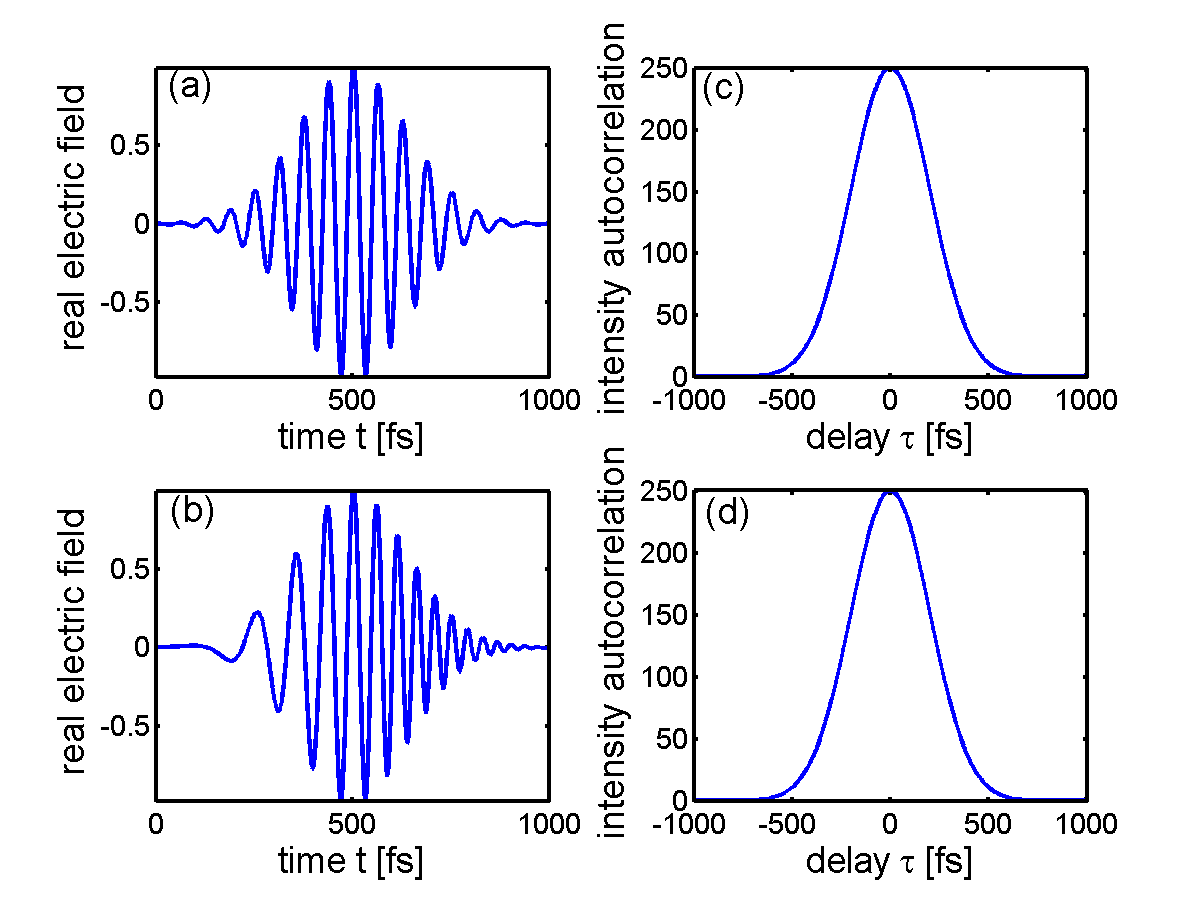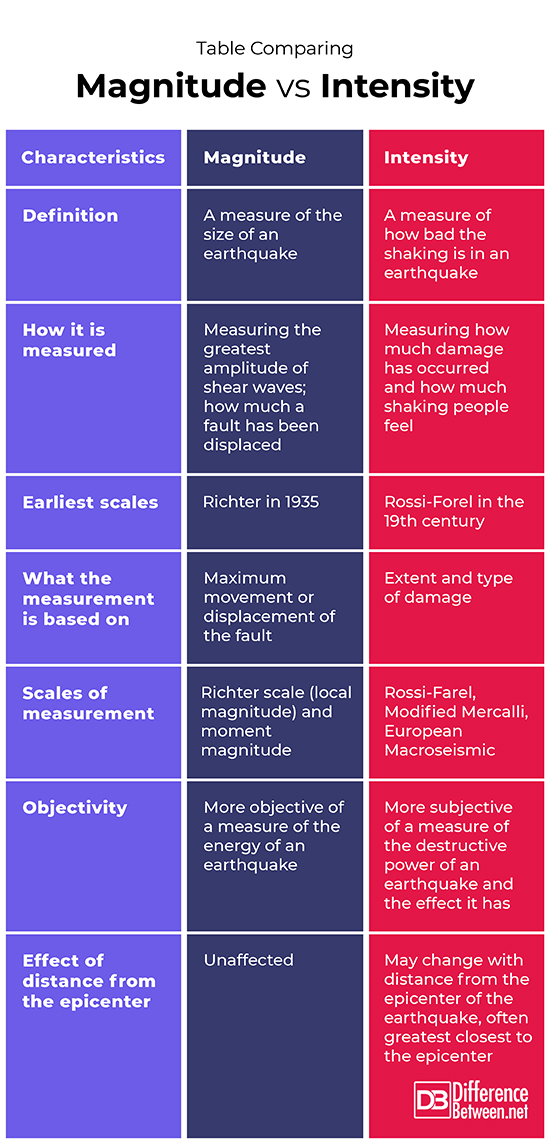Difference Between Magnitude and Intensity
Magnitude is a way to measure the size of a particular earthquake. Intensity is a way to measure how strongly the shaking is due to an earthquake.
What is Magnitude?
Definition:
Magnitude is a measure of size that is often used in geology to describe the size of an earthquake and is also believed to be a measure of the amount of energy that is released when an earthquake takes place.
How it is measured:
With earthquakes, there is a lot of movement that occurs. Magnitude is often measured as the greatest amount of movement that takes place or the largest amount of fault area that has moved.
Earliest measurements:
One of the earliest measures of magnitude for earthquakes was developed by Richter in 1935 and was based on the maximum amplitude of waves seen on a seismograph reading. This was measured as the greatest amplitude of particular waves known as shear waves. This value was then converted to a logarithmic value. Over the years there have been several ways to measure the magnitude of an earthquake, with the development of various scales.
Scales used for measurements:
Various scales have been used including the Richter magnitude, also known as the local magnitude (ML); and moment magnitude (Mw). The Mw is calculated based on how big the area of a fault is that has ruptured. Scientists have suggested that knowing the various parameters of a typical fault can be used to more accurately assess the amount of displacement and hence the magnitude of an earthquake. Today the most often used scale is the moment magnitude as it is believed to be the most accurate estimate of the size of a particular earthquake.
Examples from the real world:
The Loma Prieta earthquake which occurred in California in 1989 was measured and said to be of magnitude 6.9.
What is Intensity?
Definition:
Intensity is a measure that is often used in geology to describe how much shaking is happening when an earthquake occurs. It can be seen as a measure of how strong an earthquake is since it measures how severe the shaking is, which is affected by many factors including the type of geology of an area.
How it is measured:
The way in which intensity is measured relies on how much damage is caused and is visible after an earthquake has occurred.
Earliest measurements:
The Rossi-Forel (RF) scale was one of the earliest scales developed to measure the intensity of earthquakes. It was developed in the 19th century and had levels ranging from I to X, with corresponding levels of damage that would be noticed at each of these levels.
Scales used for measurements:
The Rossi-Forel scale and the Modified Mercalli scale are two of the ways that the intensity of an earthquake is assessed. The Modified Mercalli scale was developed to replace the RF scale which was thought by some scientists to not be very good. There are other types of scales such as the European Macroseismic Scale which are used. Complicating the issue is the fact that different countries may choose to use different scales. The Modified Mercalli Intensity (MMI) Scale is used in the United States and is based on the extent of damage caused by the earthquake to both natural and man-made structures in the landscape. Many European countries use the European Macroseismic Scale which has levels from I to XII.
Examples from the real world:
The Loma Prieta earthquake which occurred in California in 1989 was measured and estimated to have a maximum intensity of IX, meaning there was very violent shaking. Other areas affected by the same earthquake were assessed on the Mercalli scale to have an Intensity of VIII.
Difference between Magnitude vs. Intensity
-
Definition
Magnitude is really a measurement of how large an earthquake is. Intensity is a measure of how badly the ground shakes when an earthquake happens.
-
How it is measured
Magnitude can be measured by taking a measurement of the highest amplitude of the shear waves, or by recording how much a fault has been displaced. Intensity can be measured by determining how much movement a person feels and how much damage has occurred.
-
Earliest scales
The earliest scale used to determine magnitude was the Richter scale developed in 1935. The earliest scale used to determine intensity was the Ross-Forel scale developed in the 19th century.
-
What the measurement is based on
The magnitude measurement is based on the greatest amplitude of the shear waves or the amount of displacement of a fault. The intensity measurement is based on the extent and type of damage that is evident.
-
Scales of measurement
Magnitude is most often measured using either the Richter scale (local magnitude) or moment magnitude. Intensity is measured using the Rossi-Farel, Modified Mercalli, or European Macroseismic scales.
-
Objectivity
Magnitude is a more objective measure of an earthquake. Intensity is a more subjective measure of an earthquake.
-
Effect of distance from the epicenter
The magnitude of an earthquake is not affected by distance from the epicenter, it stays the same. The intensity of an earthquake is often affected by the distance from the epicenter and often is less further from the epicenter.
Table Comparing Magnitude vs. Intensity
Summary of Magnitude vs. Intensity
- Magnitude and intensity are both measurements that are done when an earthquake occurs.
- Magnitude is a measurement of the size of the earthquake as measured by waves or fault displacement.
- Intensity is a measurement of how much shaking has occurred as measured by levels of observable destruction of man-made and natural objects.
- The magnitude that is measured does not vary with distance from the epicenter.
- The intensity that is measured for an earthquake varies because it changes depending on how close or far a region is from the epicenter of the earthquake.
- Difference Between Rumination and Regurgitation - June 13, 2024
- Difference Between Pyelectasis and Hydronephrosis - June 4, 2024
- Difference Between Cellulitis and Erysipelas - June 1, 2024
Search DifferenceBetween.net :
Leave a Response
References :
[0]Image credit: https://commons.wikimedia.org/wiki/File:2017_Central_Italy_earthquake_(magnitude).svg
[1]Image credit: https://en.wikipedia.org/wiki/File:Optical-intensity-autocorrelation.png
[2]Gutenberg, Beno, and Charles Francis Richter. "Earthquake magnitude, intensity, energy, and acceleration." Bulletin of the Seismological Society of America 32.3 (1942): 163-191.
[3]Musson, Roger MW, Gottfried Grünthal, and Max Stucchi. "The comparison of macroseismic intensity scales." Journal of Seismology 14.2 (2010): 413-428.
[4]Papazachos, B. C., et al. "Global relations between seismic fault parameters and moment magnitude of earthquakes." Bulletin of the Geological Society of Greece 36.3 (2004): 1482-1489.



